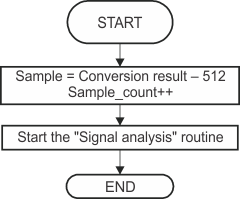SLAA351A April 2007 – November 2018 MSP430F2232 , MSP430F2232 , MSP430F2234 , MSP430F2234 , MSP430F2252 , MSP430F2252 , MSP430F2254 , MSP430F2254 , MSP430F2272 , MSP430F2272 , MSP430F2274 , MSP430F2274
3.3 ADC10
The MSP430F2274 has an integrated 10-bit analog-to-digital converter (ADC) capable of sampling rates of up to 200 ksps using the internal reference. ADC10 is turned on only at the beginning of the Timer_A ISR, to ensure low current consumption. In continuous conversion mode, the sampling frequency (fs) is set at a rate of 38.96 ksps at a typical CPU frequency of 12 MHz. The input channel to ADC10 is connected to different OAs, depending on the choice made to have the AAF. Once an active conversion is complete, the ADC10 is switched off. The ADC10 ISR is used to perform the signal analysis and determine a glass breakage. For real-time operation, the entire processing must be complete before the arrival of the next sample. This number of available CPU cycles between successive sampling instants is approximately 300.
The ADC10 ISR is active only after a valid sound event is detected. The complete signal analysis is done in this ISR. Each converted sample is converted to a bipolar signal by subtracting 512. Figure 7 shows the software flowchart in this ISR.
 Figure 7. Flowchart of ADC10 ISR Functionality
Figure 7. Flowchart of ADC10 ISR Functionality The signal analysis routine forms a major part of this ISR and is dealt with in detail in Section 3.4. ADC10 is active until 60 ms of the incoming signal is passed through a stage of preliminary processing. Further processing of this data does not require the ADC10 to remain active, and it is switched off.